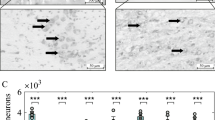Abstract
The main function of postural nervous mechanisms in different species, from mollusc to man, is to counteract the force of gravity and stabilize body orientation in space1,2,3. Here we investigate the basic principles of postural control in a simple animal model, the marine mollusc Clione limacina. When swimming, C. limacina maintains its vertical orientation because of the activity of the postural neuronal network. Driven by gravity-sensing organs (statocysts), the network causes postural corrections by producing tail flexions. To understand how this function occurs, we studied network activity by using a new method. We used an in vitro preparation that consisted of the central nervous system isolated with the statocysts. Output signals from the network (electrical activity of tail motor neurons) controlled an electrical motor which rotated the preparation in space. We analysed the activity of individual neurons involved in postural stabilization under opened or closed feedback loop. When we closed this artificial feedback loop, the network stabilized the vertical orientation of the preparation. This stabilization is based on the tendency of the network to minimize the difference between the activities of the two antagonistic groups of neurons, which are driven by orientation-dependent sensory inputs.
This is a preview of subscription content, access via your institution
Access options
Subscribe to this journal
Receive 51 print issues and online access
$199.00 per year
only $3.90 per issue
Buy this article
- Purchase on Springer Link
- Instant access to full article PDF
Prices may be subject to local taxes which are calculated during checkout






Similar content being viewed by others
References
Orlovsky, G. N. Gravistatic postural control in simpler systems. Curr. Opin. Neurobiol. 1, 612–627 (1991).
Macpherson, J. M., Deliagina, T. G. & Orlovsky, G. N. in Neurons, Networks, and Motor Behavior (eds Stein, P. S. G., Grillner, S., Selverston, A. I. & Stuart, D. G.) 257–267 (MIT Press, Cambridge, 1997).
Horak, F. B. & Macpherson, J. M. in Handbook of Phsyiology: Integration of Motor, Circulatory, Respiratory and Metabolic Control during Exercise (eds Shepard, J. & Rowell, L.) 1–39 (Oxford Univ. Press, 1995).
Arshavsky, Y. I., Beloozerova, I. N., Orlovsky, G. N., Panchin, Y. V. & Pavlova, G. A. Control of locomotion in marine mollusc Clione limacina. 1. Efferent activity during actual and fictitious swimming. Exp. Brain Res. 58, 255–262 (1985).
Arshavsky, Y. I.et al. in Simpler Nervous Systems (eds Sakharov, D. A. & Winlow, W.) 290–316 (Manchester Univ. Press, UK, 1991).
Satterlie, R. A., LaBarbera, M. & Spencer, A. N. Swimming in the pteropod mollusc Clione limacina. 1. Behavior and morphology. J. Exp. Biol. 116, 189–204 (1985).
Panchin, Y. V., Arshavsky, Y. I., Deliagina, T. G., Popova, L. B. & Orlovsky, G. N. Control of locomotion of marine mollusk Clione limacina. IX. Neuronal mechanisms of spatial orientation. J. Neurophys. 73, 1924–1936 (1995).
Alkon, D. L. Responses of hair cells to statocyst rotation. J. Gen. Physiol. 66, 507–530 (1975).
Janse, C. Sensory system involved in gravity orientation in pulmonate snail Lymnaea stagnalis. J. Comp. Physiol. A 145, 311–319 (1982).
Tsirulis, T. P. The fine structure of the statocyst in the pteropod mollusk Clione limacina. J. Evol. Biochem. Physiol. 10, 181–188 (1974).
Panchin, Y. V., Arshavsky, Y. I., Deliagina, T. G., Popova, L. B. & Orlovsky, G. N. Control of locomotion in marine mollusk Clione limacina. VIII. Cerebropedal neurons. J. Neurophys. 73, 1912–1923 (1995).
Arshavsky, Y. I., Deliagina, T. G. & Orlovsky, G. N. Patttern generation. Curr. Opin. Neurobiol. 6, 781–789 (1997).
Marder, E. & Calabrese, R. L. Principles of rhythmic motor pattern generation. Physiol. Rev. 76, 687–717 (1996).
Selverston, A. I., Panchin, Y. V., Arshavsky, Y. I. & Orlovsky, G. N. in Neurons, Networks, and Motor Behavior (eds Stein, P. S. G., Grillner, S., Selverston, A. I. & Stuart, D. G.) 105–117 (MIT Press, Cambridge, 1997).
Panchin, Y. V. Cellular mechanisms for the temperature sensitive spatial orientation in Clione. Neuroreport 8, 3345–3348 (1997).
Harris-Warrick, R. M. & Marder, E. Modulation of neural networks for behavior. Annu. Rev. Neurosci. 14, 39–57 (1991).
Selverston, A. I. Neuromodulatory control of rhythmic behaviors in invertebrates. Int. Rev. Cytol. 147, 1–24 (1993).
Selverston, A. I. Modulation of circuits underlying rhythmic behaviors. J. Comp. Physiol. A 176, 139–147 (1995).
Arshavsky, Y. I.et al. Pharmacologically induced elements of the hunting and feeding behavior in the pteropod mollusk Clione limacina. 1. Effects of physostigmine. J. Neurophys. 69, 522–532 (1993).
Deliagina, T. G. Vestibular compensation in lampreys: impairment and recovery of equlibrium control during locomotion. J. Exp. Biol. 200, 1459–1471 (1997).
Deliagina, T. G., Popova, L. B. & Grant, G. The role of tonic vestibular input for postural control in rats. Arch. Ital. Biol. 135, 239–261 (1997).
Hensler, K. in Neurobiology of Sensory Systems (eds Naresh Singh, R. & Strausfeld, N. J.) 531–554 (Plenum, New York, 1989).
Hensler, K. & Rowell, C. H. F. Control of optomotor responses by descending deviation detector neurons in intact flying locust. J. Exp. Biol. 149, 191–205 (1990).
Takahata, M., Yoshino, M. & Hisada, M. Neuronal mechanisms underlying crayfish steering behaviour as an equilibrium response. J. Exp. Biol. 114, 599–617 (1985).
Acknowledgements
We thank Ö. Ekeberg, A. Büschges and O. Bloom for comments on the manuscript. This work was supported by the grants from the HHMI (to T.G.D.), Royal Swedish Academy of Sciences (to T.G.D. and G.N.O.) and Swedish Medical Research Council (to T.G.D.).
Author information
Authors and Affiliations
Corresponding author
Rights and permissions
About this article
Cite this article
Deliagina, T., Arshavsky, Y. & Orlovsky, G. Control of spatial orientation in a mollusc. Nature 393, 172–175 (1998). https://doi.org/10.1038/30251
Received:
Accepted:
Issue Date:
DOI: https://doi.org/10.1038/30251
This article is cited by
-
An Interneuron Coordinating Tail and Wing Movement in a Pteropod Mollusk
Neuroscience and Behavioral Physiology (2014)
-
The motor infrastructure: from ion channels to neuronal networks
Nature Reviews Neuroscience (2003)
Comments
By submitting a comment you agree to abide by our Terms and Community Guidelines. If you find something abusive or that does not comply with our terms or guidelines please flag it as inappropriate.



